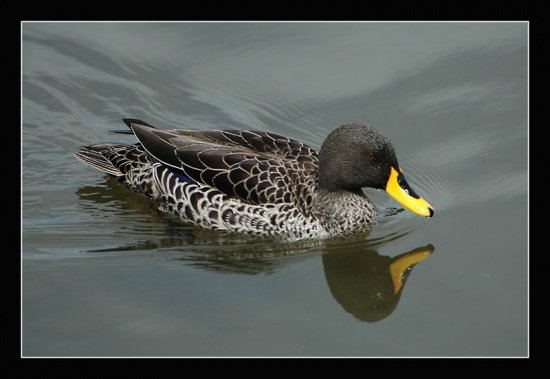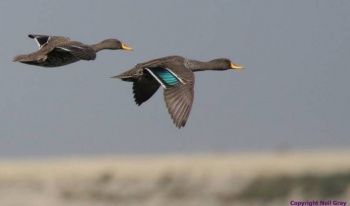(range subspecies updated) |
|||
| (6 intermediate revisions by 4 users not shown) | |||
| Line 1: | Line 1: | ||
| − | + | [[Image:Yellow-billed_Duck.jpg|thumb|550px|right|Photo by {{user|Mybs|Mybs}} <br />[[Helderberg Nature Reserve]], Western Cape, [[South Africa]], September 2004]] | |
| − | + | ;[[:Category:Anas|Anas]] undulata | |
| − | [[Image:Yellow-billed_Duck.jpg|thumb|550px|right|Photo by Mybs<br /> | ||
| − | |||
==Identification== | ==Identification== | ||
| − | ==Distribution | + | *Grey body |
| + | *Darker head | ||
| + | *Bright yellow bill | ||
| + | *Wings: white below with white-bordered green speculum (blue in the northern race)<br /> | ||
| + | Sexes similar. '''Juveniles''' slightly duller than adults | ||
| + | [[Image:21502YBDflypast.jpg|thumb|350px|right|Photo by {{user|nkgray|nkgray}}<br />Marievale wetland, Gauteng, [[South Africa]], December 2005]] | ||
| + | ==Distribution== | ||
| + | [[Africa]]<br /> | ||
| + | '''Western Africa''': [[Mali]], [[Cameroon]], [[Democratic Republic of Congo]] and [[Angola]]<br /> | ||
| + | '''Eastern Africa''': [[Sudan]], [[Ethiopia]], [[Djibouti]], [[Kenya]], [[Uganda]], [[Rwanda]], [[Burundi]], [[Tanzania]], [[Zambia]], [[Mozambique]] and [[Malawi]]<br /> | ||
| + | '''Southern Africa''': [[Namibia]], [[Botswana]], [[Zimbabwe]], [[South Africa]], [[KwaZulu-Natal]], [[Lesotho]] and [[Swaziland]]. | ||
| + | ==Taxonomy== | ||
| + | ====Subspecies==== | ||
| + | ''Anas undulata'' has two subspecies:<sup>[[#References|[1]]]</sup> | ||
| + | *''A. u. undulata'' | ||
| + | locally from Kenya and Uganda to Angola and South Africa; also local in eastern Nigeria and central Cameroon (but subspecies of this disjunct population not certain) | ||
| + | :*Locally from [[Kenya]] and [[Uganda]] to [[Angola]] and [[South Africa]]; also local in eastern [[Nigeria]] and central [[Cameroon]] (but subspecies of this disjunct population not certain) | ||
| + | *''A. u. ruppelli'' | ||
| + | :*[[Eritrea]], [[Ethiopia]], and eastern [[South Sudan]] to northern [[Uganda]] (now extirpated?) and northern [[Kenya]] | ||
==Habitat== | ==Habitat== | ||
| + | Freshwater in fairly open country. | ||
==Behaviour== | ==Behaviour== | ||
| + | ====Diet==== | ||
| + | The diet includes plant food for which it dabbles mainly in the evening or at night. | ||
| + | ====Breeding==== | ||
| + | It nests on the ground in dense vegetation near water. The clutch consists of 6-12 eggs. | ||
| + | ==References== | ||
| + | #{{Ref-Clements6thAug17}}#Avibase | ||
| + | #Wikipedia | ||
| + | {{ref}} | ||
==External Links== | ==External Links== | ||
{{GSearch|Anas+undulata}} | {{GSearch|Anas+undulata}} | ||
| − | [[Category:Birds]] | + | [[Category:Birds]][[Category:Anas]] |
Revision as of 12:01, 26 August 2017
- Anas undulata
Identification
- Grey body
- Darker head
- Bright yellow bill
- Wings: white below with white-bordered green speculum (blue in the northern race)
Sexes similar. Juveniles slightly duller than adults
Distribution
Africa
Western Africa: Mali, Cameroon, Democratic Republic of Congo and Angola
Eastern Africa: Sudan, Ethiopia, Djibouti, Kenya, Uganda, Rwanda, Burundi, Tanzania, Zambia, Mozambique and Malawi
Southern Africa: Namibia, Botswana, Zimbabwe, South Africa, KwaZulu-Natal, Lesotho and Swaziland.
Taxonomy
Subspecies
Anas undulata has two subspecies:[1]
- A. u. undulata
locally from Kenya and Uganda to Angola and South Africa; also local in eastern Nigeria and central Cameroon (but subspecies of this disjunct population not certain)
- A. u. ruppelli
- Eritrea, Ethiopia, and eastern South Sudan to northern Uganda (now extirpated?) and northern Kenya
Habitat
Freshwater in fairly open country.
Behaviour
Diet
The diet includes plant food for which it dabbles mainly in the evening or at night.
Breeding
It nests on the ground in dense vegetation near water. The clutch consists of 6-12 eggs.
References
- Clements, J. F., T. S. Schulenberg, M. J. Iliff, D. Roberson, T. A. Fredericks, B. L. Sullivan, and C. L. Wood. 2017. The eBird/Clements checklist of birds of the world: v2017, with updates to August 2017. Downloaded from http://www.birds.cornell.edu/clementschecklist/download/
- Avibase
- Wikipedia
Recommended Citation
- BirdForum Opus contributors. (2024) Yellow-billed Duck. In: BirdForum, the forum for wild birds and birding. Retrieved 25 April 2024 from https://www.birdforum.net/opus/Yellow-billed_Duck





